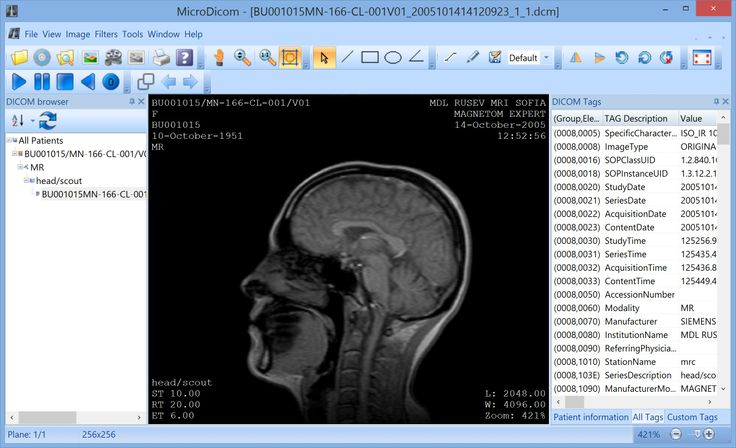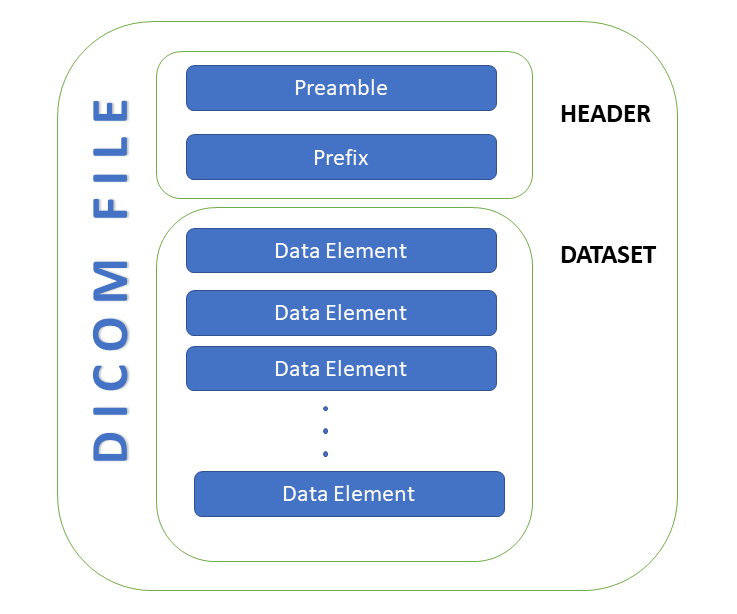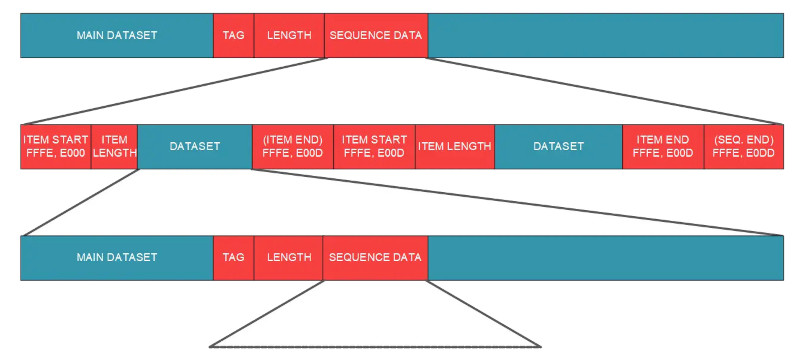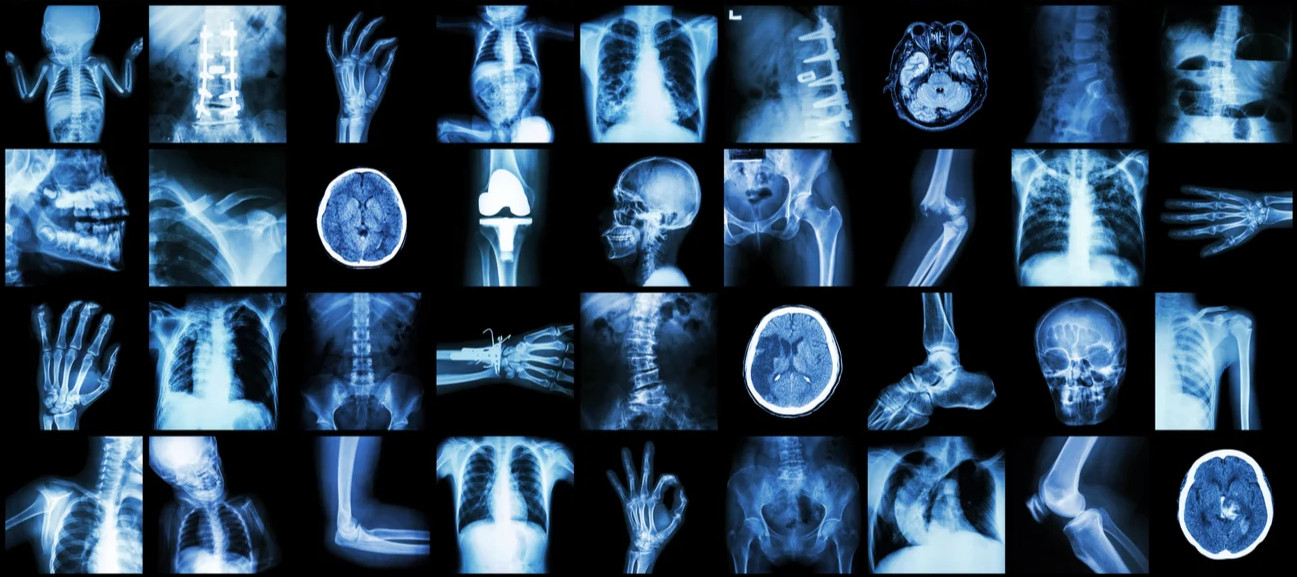DICOM File Format Basics
I would like to thank my former colleagues for introducing me to the DICOM world. It’s been a pleasure working with them and tackling many problems that come up when one tries to understand all ins and outs of such a complex standard as DICOM.
Disclaimer: Everything presented here is part of public knowledge and can be found in the resource section.
In this post I’ll try to present the basics of DICOM in plain language and provide resources that helped me along the way. The DICOM Standard can be overwhelming at first but with a nice introduction and basics the learning curve can be flattened, which is my goal.
I personally know that this post will be of interest to certain people and I’d like to encourage them to contribute and share their knowledge.
Introduction
For some odd reason you stumbled upon the DICOM Standard. Maybe at work, in a conversation or somewhere else but you decided to google it and found out that it means: Digital Imaging and Communications in Medicine.
On Wikipedia page you’ve read:
Digital Imaging and Communications in Medicine (DICOM) is the standard for the communication and management of medical imaging information and related data. DICOM is most commonly used for storing and transmitting medical images enabling the integration of medical imaging devices such as scanners, servers, workstations, printers, network hardware, and picture archiving and communication systems (PACS) from multiple manufacturers.
And of course:
The standard includes a file format definition and a network communications protocol that uses TCP/IP to communicate between systems.
Now you have a pretty good idea that the DICOM Standard defines communication protocol between different medical imaging devices and a file format.
But how is it structured and how it works? Since DICOM is enormous, where should you start?
In my opinion, the best starting point is to understand the file format and how it is used to represent medical images among other things. So, let’s look at some basic building block of DICOM file format.
DICOM file format
DICOM file can be used to represent many things: Single/Multi frame Images, Structured Reports, Encapsulated PDF storage, Videos etc.
For now we will focus only on images.
To open DICOM files you can use: MicroDicom, it’s a free DICOM viewer for Windows or if you prefer online viewer with some sample files see: DICOM Library.
When you open a file you’ll see something like this:

At the most basic level you can look at a DICOM file as a file that contains an image and information about the image: how, when, and where it’s been created, who it belongs to, device used for its creation etc, and of course the image itself. However, just like any other file format (PDF, Excel, Word …) it has a complex internal structure used for storing that information.
Structure
DICOM file is comprised of a Header and a Data Set:

-
Header, also known as DICOM File Meta Information, includes a preamble, followed by 128 byte File Preamble, followed by 4 byte DICOM prefix, followed by the File Meta Elements which include elements such as the TransferSyntaxUID (which is very important for understanding the file format).
-
Data Set is a collection of Data Elements.
DICOM Element
If you look closely at the MicroDicom preview image from above, you’ll see a list on the right hand side. That list shows DICOM attributes.
DICOM attribute (or Data Element) is a unit for storing information and it has a well predefined tag and purpose defined in the DICOM Standard (we will see later different types of tags that are not defined). For example the list can contain the following attributes:
| Tag | Tag Description | Value |
|---|---|---|
| (0002,0010) | Transfer Syntax UID | 1.2.840.10008.1.2.4.91 |
| (0008,0008) | Image Type | ORIGINAL, PRIMARY |
| (0008,0016) | SOP Class UID | 1.2.840.10008.5.1.4.1.1.2 |
| (0008,0060) | Modality | CT |
| (0010,0010) | Patient’s Name | VladSiv |
| (0010,0020) | Patient’s ID | 0123456789 |
| (0028,0100) | Bits Allocated | 16 |
| (0028,0101) | Bits Stored | 12 |
| … | … | … |
If you are interested, you can explore more attributes by browsing: Registry of DICOM Data Elements
Attributes are composed of, at least, three fields:
- Tag - identifies the element
- Value Length (VL) - defines the length of the attribute’s value
- Value Field (VF) - contains the attribute’s data
And for some types of Transfer Syntaxes (we will see later what they are), there is another field:
- Value Representation (VR) - describes the data type and format of the attribute’s value
Visually we can represent that as:

Tags
Every DICOM element has a Tag that uniquely indetifies the element and is
represented as: (gggg,eeee), where gggg represents the Group Number and
eeee the Element Number.
Group and Element numbers are 16-bit unsigned integers and are represented in hexadecimal notation.
A Group is a collection of elements that are somehow related, for example:
| Tag | Tag Description |
|---|---|
| (0010,0010) | Patient’s Name |
| (0010,0020) | Patient ID |
| (0010,0021) | Issuer of Patient ID |
| (0010,0022) | Type of Patient ID |
| (0010,0030) | Patient’s Birth Date |
| (0010,0040) | Patient’s Sex |
| … | … |
Actually, a Group belongs to an attribute of an abstract concept called Information Object Definition (IOD) and the Patient group to Patient Module - I’ll explain how it works later.
Value Length
Depending on VR, VL can be of defined or undefined lenght. If it’s defined then it’s a 16 or 32-bit unsigned integer containing the explicit length of the Value Field as the number of bytes that make up the Value.
Value Field
Represents an even number of bytes containing the Value of the Data Element. It’s obvious that the data type of the stored Value depends on VR as explained above.
However, VF can contain multiple values and that’s defined by Value Multiplicity (VM). For data elements that are defined in the Standard, each element has a defined VM and if it is greater than 1, multiple values are delimited within the VF.
To see VMs of tags defined in the DICOM Standard, please see: Registry of DICOM Data Elements
Value Representation
VR is really important as it defines how the VF will be interpreted. The most important thing to remember is that VR can be:
- Explicit - Is contained in Data Element
- Implicit - Is missing from Data Element
You may be asking now, if it’s missing how do we know how to interpret the VF?
Well, it’s defined in the Standard, and when you get the Tag (gggg,eeee) you
know what to expect, that’s why it’s implicit. If something is not right, and
for example your application cannot parse the data element, then the data
element is not encoded in accordance with the Standard.
If it’s present in the data element. It contains two byte characters which are always encoded using upper case letters.
The list of possible VRs is quite extensive and details about encoding, character repertoire, and length of value can be found in the Standard: Value Representation
To mention some of them:
| VR | Name |
|---|---|
| CS | Code String |
| DS | Decimal String |
| DT | Date Time |
| LO | Long String |
| LT | Long Text |
| OB | Other Byte |
| PN | Person Name |
| SH | Short String |
| SQ | Sequence of Items |
| … | … |
Public and Private
The DICOM Standard allows private data elements which don’t belong to Standard Data Elements i.e. are not defined in the Standard. This allows different implementations of communication of information. For example, private elements can be used by different machine manufacturers to specify element where the proprietary data is stored.
However, private data elements have to have the same structure as Standard Data Elements i.e. Tag, VL, VF, VR, VM etc.
How do we distinguish between private and public elements?
It’s easy, public elements have an even Group number, while private groups have odd numbers.
Note: Elements with Tags
(0001,xxxx),(0003,xxxx),(0005,xxxx),(0007,xxxx), and(FFFF,xxxx)cannot be used. To learn more about implemention of private tags please see: Private Data Element Tags
Type of elements
DICOM attributes may be required in a Data Set (depending on IOD or a SOP class, we will define them later).
Some of the attributes are mandatory, others are mandatory under certain conditions and of course, some are completely optional.
There are 5 types:
- Type 1: Required data element, it cannot be empty. Absence of a value of a Type 1 data element is a protocol violation
- Type 1C: Same as Type 1 but is required under certain conditions
- Type 2: Required data element, but it can be empty if the value is unknown. For example, think of the Patient’s name, it is a required element but the actual name i.e. value can be unknown at the moment of performing a scan.
- Type 2C: Same as Type 2 but is required under certain conditions
- Type 3: Optional tags
Nested Tags
You can define nested tags in a DICOM Data Set, this is done using Sequence of Items (SQ) VR as mentioned above. This allows you to define a tag that has a sequence of items, where each item contains a set of Data Elements.
For example, tag: (0010,1002) - Other Patient IDs Sequence; can contain many
items that represent Patient ID Data Set. If you are familiar with JSON
objects, you can look at it like:
{
"Other Patient IDs Sequence": [
{
"PatientID": "id",
"Issuer of Patient ID": "issuer",
"Type of Patient ID": "type",
"Issuer Of Patient ID Qualifiers Sequence": {
"Universal Entity ID": "uni",
"Universal Entity ID Type": "uni_type",
...
}
},
{...},
{...}
]
}
To be more precise about the structure of these items and nested data set, we could depict it:

If you would like to know more about encoding of nested data sets, please see: Nesting of Data Sets
Transfer Syntax
We now know that we can have different types of tags and value representations, also that they can be implicit or explicit. When dealing with objects in general we have to store them somehow and send them to different applications. Basically, everyone should know how to read and use the object. To put it more precisely, everyone should be able to serialize and deserialize a DICOM object.
Transfer Syntax does exactly that, it tells you how to read a DICOM object. It defines three things:
- Explicit/Implicit VR - If VRs are present in a Data Element or not
- Big/Little Endian - Byte ordering, see: Endianness
- Native/Encapsulated Pixel Data - If pixel data is compressed and what compression algorithm is used
However, the Transfer Syntax applies only to the Data Set part of a DICOM file, while the File Meta Information has always the same encoding. To quote the DICOM Standard:
Except for the 128 byte preamble and the 4 byte prefix, the File Meta Information shall be encoded using the Explicit VR Little Endian Transfer Syntax as defined in DICOM PS3.5. The Unknown (UN) Value Representation shall not be used in the File Meta Information. Ref: DICOM File Meta Information
So, to read a DICOM file, you have to:
- Skip preamble (Why? See: Preamble Hack)
- Confirm that it’s indeed a DICOM file, by reading bytes 128-131 which should be “DICM” i.e. DICOM prefix (don’t rely on extenstions, it could be anything and is not specified in the Standard)
- Start parsing all
0002tags with Explicit VR Little Endian - Get
(0002,0010)- TransferSyntaxUID and use it to parse the Data Set
Transfer Syntaxes are defines with UIDs:
| Transfer Syntax Name | Transfer Syntax UID |
|---|---|
| Implicit VR Endian: Default Transfer Syntax for DICOM |
1.2.840.10008.1.2 |
| Explicit VR Little Endian | 1.2.840.10008.1.2.1 |
| Deflated Explicit VR Little Endian | 1.2.840.10008.1.2.1.99 |
| JPEG Baseline (Process 1): Default Transfer Syntax for Lossy JPEG 8-bit Image Compression |
1.2.840.10008.1.2.4.50 |
| JPEG-LS Lossless Image Compression | 1.2.840.10008.1.2.4.80 |
| … | … |
To get the full list of available Transfer Syntax UIDs, please see: Registry of DICOM Unique Identifiers
SOP Class
When it comes to information objects in the DICOM Standard, there is a lot of abstract definitions, and I just mentioned some of them like Information Object Definition (IOD) and Module.
These topic go beyond the basics of the file format but I’ll try to give you some really rough guidelines on how it works.
If you are familiar with Object Oriented Programming (OOP) you already know that we try to model information in object-oriented abstract data models that are used to specify information about the real world objects. In DICOM this class is represented as IOD. We can use this class as a template and instantiate it with attributes and that gives us a particular Data Set.
Attributes of an IOD describe a property of a real world object and are grouped into Information Entities or Modules, depending if IOD is Normalized or Composite.
If you are new to DICOM Standard, you may be asking: What in hell are you
talking about?
And I get your point, I like thinking about abstract concepts
but to really grasp them, they need to be introduced in an undestandable way
that showcases a real world application.
If you open: Dicom Standard Browser. You’ll see a list of Composite IODs (CIOD), and there are many of them, such as: CR Image, CT Image, MR Image, US Image, Encapsulated PDF, etc. When you open one of them you’ll see Modules, which can be Mandatory (M) or User Optional (U). These CIOD actually represent a template which is instantiated from an abstact class, which we mentioned.
All DICOM objects have to include a SOP Common Module, likewise if DICOM object represents an image, it should include an Image Module. Other main modules are: Patient, Study and Series. Additionally, there are specific modules, if we define a DICOM object as a CR Image, we must include a CR Image Module and so on…
Service-Object Pair Class (SOP Class) - contains the rules and semantics that may restrict the use of the service in the DICOM Message Service Element (DIMSE) Service Group and/or the attributes of the IOD. This basically means that by defining a SOP Class of a DICOM object it specifies the mandatory and optional modules of an IOD.
DIMSE is connected to the part of DICOM Standard that deals with the protocol. This is not in the scope of this basic introduction, but if you are interested check out: Dicom Part 7 - Message Exchange
SOP Class is defined by SOPClassUID and is always present in a DICOM file in the (0008,0016) Data Element. Let’s look at some examples:
| SOP name | SOPClassUID |
|---|---|
| CR Image Storage | 1.2.840.10008.5.1.4.1.1.1 |
| CT Image Storage | 1.2.840.10008.5.1.4.1.1.2 |
| NM Image Storage | 1.2.840.10008.5.1.4.1.1.20 |
| MR Image Storage | 1.2.840.10008.5.1.4.1.1.4 |
| Encapsulated PDF Storage | 1.2.840.10008.5.1.4.1.1.104.1 |
| Ultrasound Image Storage | 1.2.840.10008.5.1.4.1.1.6.1 |
| Video Photographic Image Storage | 1.2.840.10008.5.1.4.1.1.77.1.4.1 |
| … | … |
If you are interested in more SOP Class UIDs, please see: Registry of DICOM Unique Identifiers
Now that we understand the SOP Class, it’s important to understand that when we create a DICOM file, this file is an instance of the SOP Class. That’s why we have a Data Element: SOPInstanceUID which is globally unique in a DICOM file.
Of course, there are other instances, for example: StudyInstanceUID - uniquely identifies a study, which can contain many series that are identified using SeriesInstanceUID and so on…
Preamble Hack
In 2019, a new hack surfaced and it used DICOM files to enable malware to infect patient data. It used the Preamble to insert itself into DICOM files and exploit flaws in the design of DICOM.
We know that the Preamble is a part of the Header and that it represents a 128-byte section. The purpose of this section is to allow applications to use it for specific implementations. For example, it could be used to contain information enabling a multi-media applications to randomly access images stored in a DICOM Data Set or any other specific implementation.
The important thing here is that the DICOM Standard does not require any structure and does not impose any requirements on the data inserted into the Preamble. Basically we can insert whatever we want. This allows hackers to masquerade an executable file as a DICOM image which will trigger an execution of the malware.
If you’d like to find out more about this hack, please read: HIPAA-Protected Malware? Exploiting DICOM Flaw to Embed Malware in CT/MRI Imagery
Final Words
If you are just starting out with the DICOM Standard it can be daunting when you look at the DICOM Standard, 22 parts where, for example, part 3 has 1802 pages in PDF format. Just skimming through the whole Standard can take a while :D
The aim of this article is to introduce the basic concepts, related to the file format, in a clear and concise manner. Grasping the basics will give you a good starting point for exploring the whole Standard.
I hope that this article gets you interested in the DICOM world and encourages you to dive deeper and research referenced material.
If you have any questions or suggestions, please reach out, I’m always available.
Resources
- DICOM Standard - Online DICOM Standard, Current Edition
- DICOM Standard Browser - Standalone website that offers quick and really pleasent overview of DICOM attributes
- DICOM is Easy - Great blog about sofware programming for medical applications
- DICOM sample files:

Leave a comment